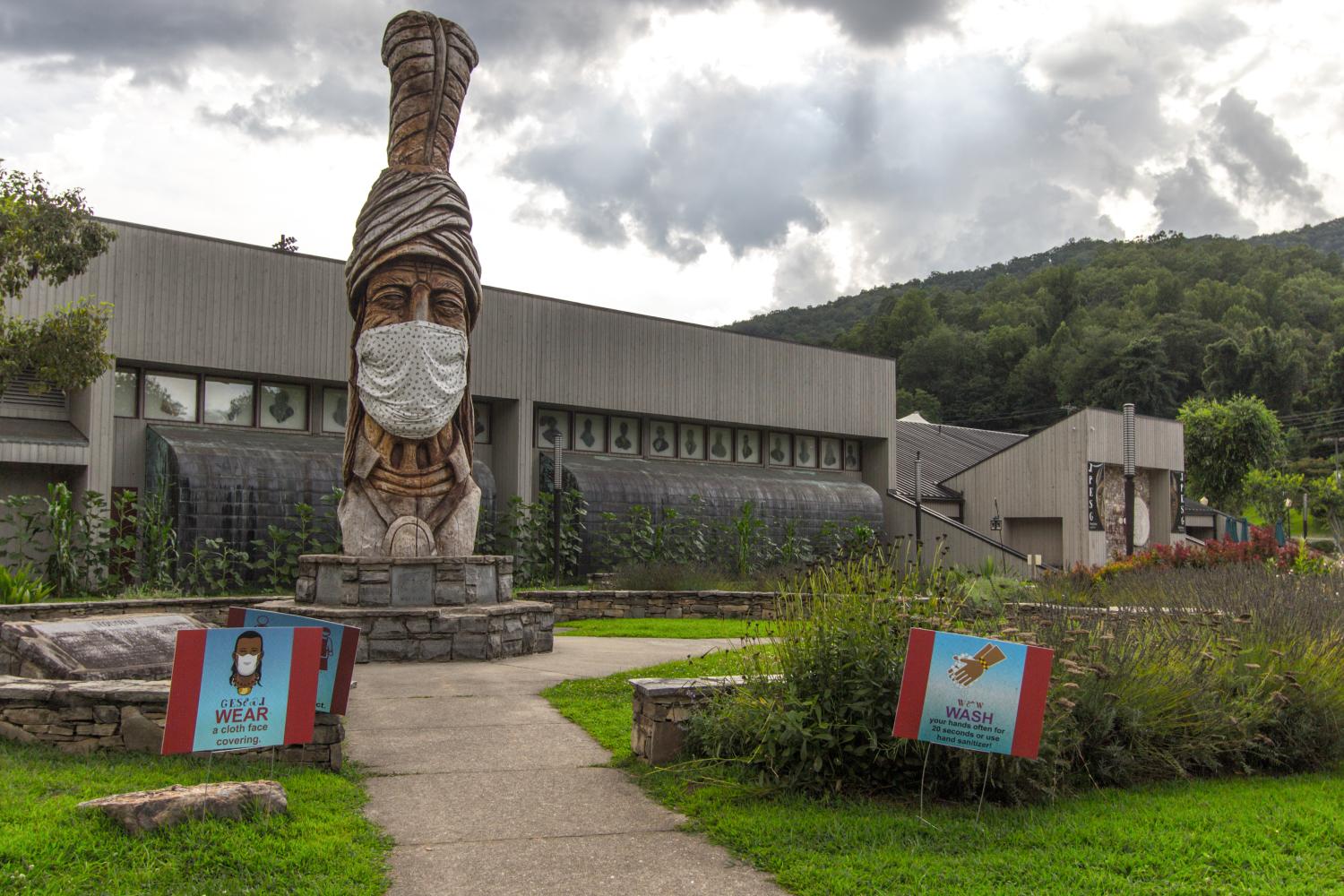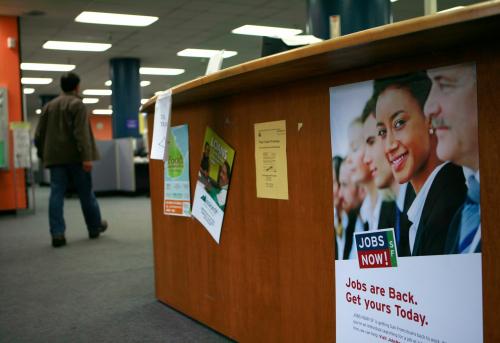The Bureau of Labor Statistics’ (BLS) August jobs report showed a labor market that, while not as hot as earlier in the year, is still showing significant growth. But despite that growth, there remains serious variation in the economic health of different racial and ethnic groups. Namely, August’s unemployment rate for Native Americans was 4.9%—which, while significantly better than its early pandemic peak of 28.6%, is still over a percentage point higher than the national seasonally unadjusted unemployment rate of 3.8%.1
In this piece, we report on an important facet of the pandemic economy that has affected how well Native Americans have been able to access employment over the past two years: their ability to work remotely compared to other racial and ethnic groups.
According to the Census Bureau, in early summer 2020, at the height of the COVID-19 economic crisis, Native Americans worked remotely due to the pandemic at a rate 8 percentage points lower than white workers. As workers returned to the office in 2021 and 2022, that gap closed but never disappeared, and by early summer 2022, Native Americans were still working remotely due to the pandemic at a rate 2 percentage points lower than white workers.
An important predictor of this racial gap is differences in the jobs that Native American workers hold compared to white workers; we find that job differences explain nearly the entire remote work gap during the first year of pandemic-era data. However, as the pandemic progressed, occupation has become a less significant factor in explaining this gap, while other factors may have begun to play a more important role.
As research continues to emphasize the benefits of remote work, this analysis suggests that Native American workers are being left behind.
Remote work can strengthen Native nations by averting out-migration
The benefits of remote work include reduced exposure to COVID-19, improved work-life balance, shorter commute times, and increased employee morale and job satisfaction.
However, these benefits are not distributed equally across different demographic groups. For example, University of Pennsylvania Professor Martine Haas has made the case that some hybrid work environments may put women at a disadvantage. And even as media outlets and researchers have begun to emphasize the benefits of remote work, fewer analyses have focused on its racial disparities.
For Native nations, remote work has the potential to bring new economic opportunity. This matters because Native nations differ from many other communities in that out-migration not only has economic impacts, but is also a threat to cultural well-being. For individual tribal citizens, out-migration makes it more difficult to maintain ties to their culture and fellow citizens, particularly across multiple generations. For Native nations as a whole, population loss weakens their ability to operate as sovereign political entities.
Remote work has the potential to address these challenges by creating new opportunities for Native American workers to connect with jobs without leaving their community, as well as for Native-owned firms to connect with workers while still being based in their tribe’s homelands.
Occupational and structural challenges are restricting remote work for Native Americans
The number of people working remotely due to the pandemic has declined from its early pandemic high, but the racial disparities in remote work activity have remained consistent.
Since May 2020, survey participants in the Census Bureau’s Current Population Survey (CPS)—which is used to calculate the official unemployment rate—have been asked whether they worked remotely for pay during the past month because of the COVID-19 pandemic. This data on remote work allows researchers and policymakers to understand changes to the work environment caused by the pandemic.
Figure 1 shows the share of employed workers who worked remotely due to the pandemic from May 2020 to June 2022, using a three-month rolling average.2 The data shows that remote work continues to decline from its early pandemic high—driven not by improvements in labor force participation, but rather by an absolute decrease in the number of workers reporting that they worked from home due to the pandemic.
Throughout this period, we see consistent racial disparities in remote work activity. From May to July 2020, 23% of Native American workers were able to work remotely—a share that lagged other racial groups and was 8 percentage points lower than white workers’ share. Over time, the remote work gap between Native American and white workers has been cut in half in percentage point terms, but the share of Native American workers who work remotely has remained consistently below those of both white and Black workers.
 Past research has shown that Native Americans have a distinct occupational distribution that has impacted their ability to work remotely. While part of this distinction is due to cultural factors that affect which occupations Native American workers choose, a significant portion of it is also due to the opportunities they have—and don’t have—access to. Native Americans tend to be overrepresented in certain frontline occupations (which often cannot be done remotely) and underrepresented in occupations that require a college degree (which are more likely to be able to be done remotely).
Past research has shown that Native Americans have a distinct occupational distribution that has impacted their ability to work remotely. While part of this distinction is due to cultural factors that affect which occupations Native American workers choose, a significant portion of it is also due to the opportunities they have—and don’t have—access to. Native Americans tend to be overrepresented in certain frontline occupations (which often cannot be done remotely) and underrepresented in occupations that require a college degree (which are more likely to be able to be done remotely).
To demonstrate the importance of occupational differences in explaining the observed racial gap in remote work, we calculated the Native American remote work rate if the Native American workers held the same distribution of jobs as white workers. This technique creates a counterfactual (or “job-adjusted”) racial remote work gap. We also looked at the CPS data across two time periods: the first year of pandemic data (from May 2020 to April 2021) and the second year of pandemic data (from May 2021 to April 2022). While these dates are somewhat arbitrary, we split the data to determine if the correlation between occupation and remote work has changed over the course of the pandemic recovery.
As shown in Figure 2, differences in Native Americans’ job distribution accounted for nearly all of the racial disparities in remote work between Native American and white workers during the first time period (May 2020 to April 2021). Thus, if Native American workers held the same job distribution as white workers, there would have effectively been no racial gap in remote work during this time.
 In the second time period analyzed (May 2021 to April 2022), the Native-white remote work gap is half of what it previously was. And occupational differences no longer account for nearly all of the remaining gap; roughly one-quarter of the Native-white remote work gap is unexplained during this period. If differences in the jobs that Native American and white workers hold are unable to fully account for the difference in remote work rates, what other factors may help explain the gap?
In the second time period analyzed (May 2021 to April 2022), the Native-white remote work gap is half of what it previously was. And occupational differences no longer account for nearly all of the remaining gap; roughly one-quarter of the Native-white remote work gap is unexplained during this period. If differences in the jobs that Native American and white workers hold are unable to fully account for the difference in remote work rates, what other factors may help explain the gap?
While it’s impossible to say with full confidence what factors are driving this disparity, there are several candidates. Work by scholars Francesco Armillei, Tito Boeri, and Thomas Le Barbanchon identified three factors that help explain inequality in remote work: 1) the structural conditions of a worker’s home; 2) workers’ access to the necessary technology and furniture to do their jobs from home; and 3) workers’ family conditions. Across all three dimensions, Native American workers face more challenges than workers of other races.
For example, Native Americans live in overcrowded housing at a rate higher than any other racial group, and likely have fewer rooms available to convert into workspaces. Beyond space considerations, inadequate construction may mean Native American workers face challenges around soundproofing or lighting that make remote work difficult.
Housing isn’t the only infrastructure shortcoming Native American workers face. Native American communities are underserved by broadband internet providers, and even with an array of federal programs designed to support broadband access in these places, the lack of density on many reservations—rural ones in particular—makes broadband prohibitively expensive. While the CARES Act and the Infrastructure Investment and Jobs Act have provisions to expand broadband access in rural Native communities, the amount of investment needed is so large that these bills alone aren’t enough to solve the problem.3 Moreover, some Native American households may lack a computer, relying instead on mobile devices to access the internet, which greatly limits their ability to work remotely.
Additionally, Native Americans tend to live in multigenerational housing at higher rates than other workers, which can exacerbate the challenges related to remote work. While on one hand, remote work can support family and caregiving duties, these responsibilities can also have negative impacts on productivity.
Finally, the role of employment discrimination can’t be discounted when considering Native Americans’ access to jobs that allow for remote work. Multiple scholars have found that even when controlling for educational disparities, Native Americans still tend to end up in jobs that require less education and have worse labor market outcomes—with the effects of the latter being particularly strong in states where Native Americans make up a larger share of the population. This may be a function of discrimination that Native Americans face in the labor market, which would in turn affect their ability to work remotely.
In sum, rather than unlocking new opportunities for Native American workers to connect with far-flung employers via remote work, the pandemic instead seems to have entrenched existing labor market inequalities. This demonstrates the urgent need for the federal government to live up to its trust and treaty obligations to Native nations, particularly in the areas of economic development and education.
Expanding Native Americans’ access to remote work will require sustained federal investment
As the pandemic continues to evolve, remote and hybrid work environments appear here to stay. To ensure just and equitable access to these work environments and their benefits, policymakers will need to make deliberate investments on behalf of Native American workers.
In the immediate term, the BLS can continue to expand the amount of information available about Native Americans workers. For example, while the BLS publishes monthly data on Native American unemployment (along with other races), these publications would benefit from the inclusion of additional labor market conditions, such as the racial disparity in remote work. Making more data on Native Americans’ work conditions public would be a small step forward.
Congress’ surge of pandemic-era spending is partially addressing other barriers to remote work in rural tribal communities, such as high-speed broadband access and housing infrastructure. But these barriers are the results of centuries of shortcomings in federal funding, and will require additional, sustained investment over years or decades.4 Policymakers could consider a new tribal-focused infrastructure bill, with the goal of expanding investments in housing and digital infrastructure.
The types of industries and occupations available on tribal lands represent another major barrier to remote work for Native Americans. There have been significant federal investments in Native nations recently, including $130 million to three Indigenous-led projects through the Economic Development Administration’s Build Back Better Regional Challenge (BBBRC) and $100 million for the agency’s Indigenous Communities program. Moving forward, policymakers should take further steps to promote economic density and diversity within Native nations. One model, originally suggested by UCLA scholar Randall Akee, could be a “race to the top”-style challenge grant to encourage diversity in Native nations’ economic activities. A “Native Homeland Economic Development Grant” on the scale of the BBBRC could be transformative for some Native nations. At the same time, policymakers could make complementary investments to support digital skills development for Native American workers, providing them with the tools they need to succeed in remote work environments.
Education is another area where the federal government has fallen short of its trust and treaty obligations to tribes. In addition to pre-K-12 education, Congress needs to do more to fully fund tribal colleges and universities (TCUs) as well as support Native American-serving nontribal institutions (NASNTIs). As mentioned previously, jobs that allow remote work are more accessible to workers with a college degree, and evidence shows that TCUs and NASNTIs can provide Native American students with a culturally relevant college environment where they can thrive. Moreover, TCUs and NASNTIs not only educate Native American students, but also serve as anchor institutions for Native nations. Greater investment can expand their roles as community and economic development anchors—in turn, helping to diversify these communities’ industry mix.
Finally, more needs to be done to help Native Americans who don’t live or work on tribal land access better-paying jobs, which are more likely to have a remote work option. Unfortunately, the U.S. government has a destructive history with workforce development for urban Native Americans. Given that, the federal government should scale up funding for Native American-led workforce development intermediaries in metropolitan areas, such as the American Indian Opportunities Industrialization Center in Minneapolis. Scaling up Native American-led programs like these not only helps provide culturally appropriate services, but can also help job seekers to tap into broader networks of Native American workers and Native American-led employers.
In conclusion, remote work by itself has important benefits—but it’s also a proxy for how well certain groups can access good-paying work. That Native Americans consistently have the lowest access to remote work indicates the continued challenges they face in the U.S. labor market.
-
Footnotes
- The official monthly unemployment rate published by the Bureau of Labor Statistics provides seasonally unadjusted data only for workers who identify as American Indian or Alaska Native alone. However, for reasons outlined in previous work, that definition is insufficient for assessing the true scope of Native American involvement in the U.S. labor market. For the purposes of this piece, the authors define “Native American” as inclusive of all workers identifying as American Indian or Alaska Native alone or in combination with one or more other races.
- We use a three-month rolling average to display the racial disparity in remote work in order to smooth out large monthly changes in the racial gap caused by the small sample sizes of Native American workers in the CPS.
- The $980 million Tribal Broadband Connectivity Program received more than 280 applications, totaling over $5 billion in funding requests. While the Infrastructure Investment and Jobs Act contained an additional $2 billion for tribal broadband, even that additional amount wouldn’t be enough to cover every funding request—let alone the needs for tribes that didn’t apply, or the needs of Native Americans not living on tribal land.
- As one example, the National American Indian Housing Council estimates that over $4 billion in federal funding was appropriated to tribal housing programs in 2020 and 2021—the largest investment in modern history. However, a 2017 assessment of housing needs in tribal areas found that 68,000 additional housing units were needed to replace inadequate units and eliminate overcrowding, while an additional 30,000 units needed rehabilitation. A conservative way to estimate the cost of closing the existing housing gap would be to assume that it could be met entirely by constructing manufactured homes, which cost significantly less than traditional site-built homes, and could be built entirely on reservation or trust land, which means land is already secured. While these assumptions are unrealistic, they can at least provide an order of magnitude as to whether federal investments to date have been sufficient. In 2022, a single-section manufactured home cost $72,600, according to the Manufactured Housing Institute. In many cases, the house will need to have electric, heating, and septic installed, which may cost an additional $10,000. At a price of $84,600 per unit, the cost to build just the 68,000 units would be over $5.6 billion. The cost to rehabilitate the additional 30,000 units would be several billion additional dollars. Moreover, some estimate that the real housing shortfall is larger, perhaps as much as three times as large. Meanwhile, Native Americans in urban areas face additional housing challenges that aren’t accounted for in the estimates of housing needs on tribal land. In sum, even a historically large investment of $4 billion covers just a fraction of the real housing needs in Indian Country.
The Brookings Institution is committed to quality, independence, and impact.
We are supported by a diverse array of funders. In line with our values and policies, each Brookings publication represents the sole views of its author(s).




